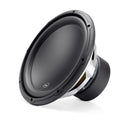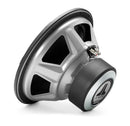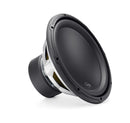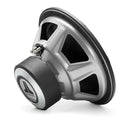







Summary
This powerhouse 12-inch driver delivers potent performance and world-class sound quality in medium power applications. Several exclusive JL Audio technologies and proprietary assembly techniques are applied to the 12W3v3 to enhance linearity and reliability.
The 12W3v3-2 is best used with amplifier power in the 150W - 500W range and is optimized to operate in a compact 1.25 cu. ft. (35.4 l) sealed enclosure, or a 1.75 cu. ft. (49.6 l) ported enclosure. Detailed enclosure recommendations can be found in the "Specifications" tab.
Overview

Dynamic Motor Analysis - DMA Optimized Motor
Summary:
JL Audio's proprietary Dynamic Motor Analysis system is a powerful suite of FEA-based modeling systems, first developed by JL Audio in 1997 and refined over the years to scientifically address the issue of speaker motor linearity. This leads to vastly reduced distortion and faithfully reproduced transients... or put simply: tight, clean, articulate bass.
Detailed Information:
Since 1997, JL Audio has been at the forefront of Finite Element Analysis-based modeling of loudspeaker motors and suspensions. This research is aimed at decoding what we refer to as the "Loudspeaker Genome"... a project aimed at understanding the true behavior of loudspeakers under power and in motion. A major component of this integrated system is DMA (Dynamic Motor Analysis). Starting with the 15W3v3 and the W7 Subwoofers in the late 1990's and early 2000's, DMA has played an important role in the design of all JL Audio woofers sold today, including our component woofers.
DMA is a Finite Element Analysis (FEA)-based system, meaning that it takes a large, complex problem, breaks it down into small solution elements for analysis and then assembles the data to form an accurate, "big-picture" solution. DMA's breakthrough is that it actually considers the effects of power through the coil as well as coil/cone position within the framework of a time-domain analysis. This gives us a highly accurate model of a speaker's actual behavior under real power, something that the traditional Thiele-Small models or other low power measurements cannot do. Because DMA does not rely on a steady-state model, it is able to consider shifts in the circuit elements being analyzed. These modeling routines are intense, requiring hours to run for a whole speaker.
DMA is able to analyze the real effects of fluctuating power and excursion upon the magnetic circuit of the motor, specifically the dynamic variations of the "fixed" magnetic field. This delivers intensely valuable information compared to traditional modeling, which assumes that the "fixed" field produced in the air gap by the magnet and the motor plates is unchanging. DMA not only shows that this "fixed" field changes in reaction to the magnetic field created by current flowing through the voice coil, but it helps our engineers arrive at motor solutions that minimize this instability. Analyzing this behavior is critical to understanding the distortion mechanisms of a speaker motor and sheds light on the aspects of motor design that determine truly linear behavior:
- Linear motor force over the speaker's operational excursion range
- Consistent motor force with both positive and negative current through the coil
- Consistent motor force at varying applied power levels
Our ability to fully analyze these aspects of motor behavior allows our transducer engineers to make critical adjustments to motor designs that result in extremely linear, highly stable dynamic loudspeaker motor systems.
The payoff is reduced distortion, improved transient performance and stellar sound quality.

Elevated Frame Cooling (U.S. Patent #6,219,431 & #6,229,902)
Summary:
JL Audio's patented Elevated Frame Cooling design delivers cool air through slots directly above the top-plate to the voice coil of the speaker. This not only enhances power handling, but also sound quality by minimizing dynamic parameter shifts and power compression.
Detailed Information:
Many speakers employ venting techniques to enhance voice coil cooling. This is typically accomplished by having big holes in the sides of the frame just below the spider attachment shelf. While it provides a modest cooling benefit, this low-velocity air-flow does not blow directly or strongly on the voice coil.
Our patented design improves upon this cooling technique in a number of ways. By elevating the frame above the top-plate of the motor (via stand-offs integrated into the bottom of the frame) a narrow, high-velocity air-path is created between the bottom surface of the frame and the top surface of the top-plate. This air path leads directly to the voice coil and then turns upward into the spider air cavity. By utilizing the pumping action of the spider through this focused air path, a large volume of cool air hits the coil windings directly.
Another important benefit is that the upper surface of the top-plate (one of the speaker's hottest parts) is directly exposed to cooling air flow, whereas on a conventional design it is isolated from the air flow by the lower flange of the frame. The elevated frame technology greatly increases thermal power handling, reduces compression effects and does so without any additional parts.

Floating Cone Attach Method - FCAM™ (U.S. Patent #6,501,844)
Summary:
This assembly technique, conceived by JL Audio, ensures proper surround geometry in the assembled speaker for better excursion control and dynamic voice coil alignment.
Detailed Information:
JL Audio's patented FCAM™ technology is an innovative method of bonding the surround/cone assembly to the voice coil former/spider assembly. This feature helps ensure concentricity of the surround, spider and voice coil without torquing the suspension to achieve it. This allows for the inevitable, slight variations in production part dimensions without having them negatively impact the integrity of the suspension and coil-centering at high excursions.

Vented Reinforcement Collar (U.S. Patent #5,734,734)
Summary:
JL Audio's patented Vented Reinforcement Collar (VRC®) improves the rigidity and stability of the cone/spider/voice coil junction and directs airflow over the voice coil windings for improved thermal performance.
Detailed Information:
The Vented Reinforcement Collar (VRC®) is a composite structure that addresses two issues related to reliability.
By reinforcing the critical junction betweeen the cone, voice coil and spider, the VRC greatly reduces failures due to glue breakdown or material weakness. It does this by greatly increasing adhesive contact area and providing stress relief to the spider material at excursion extremes.

The VRC™ also features slots that facilitate air flow directly onto the voice coil windings. This reduces thermal compression effects and enhances reliability.
Current versions of the VRC™ also incorporate lead-wire strain relief structures to improve mechanical reliability.

Insert Molded Suspension / Coil / Terminal Sub-Assembly (U.S. Patent #7,379,558)
Summary:
Spiders, voice coils, terminals and lead wires are preassembled, using a patent-pending process, onto a composite carrier for improved precision and reliability.
Detailed Information:
A conventional speaker is assembled in layers. In other words, multiple parts are assembled and glued sequentially into the basket, leading to stacking of tolerances and making it difficult to achieve optimal assembly precision.
JL Audio's patent-pending insert-molded spider carrier permanently bonds the spider to a mechanically robust carrier that also incorporates the terminal assembly and lead wire strain relief features for enhanced relability and optimal alignment of parts. This subassembly is assembled outside the speaker basket, for optimum alignment and glue-joint integrity. The benefit is a more precisely built, more mechanically sound loudspeaker.

Customizable Trim Ring (U.S. Patent #D480,709)
Summary:
This removable ring can be painted to match the installation theme and directly receives JL Audio grille mesh inserts (sold separately).
Detailed Information:
This ABS trim ring is molded in black, but that doesn't mean it has to stay that way. By custom painting it, you can match your installation theme and create a personalized look.
Specifically-designed grille mesh inserts are available separately and fit into the inner diameter of the trim ring.
Helpful Tip: Installing the grille mesh inserts is much easier before mounting the woofer into the enclosure.

Engineered Lead-Wire System (U.S. Patent #7,356,157)
Summary:
Carefully engineered lead-wire design and attachments ensure controlled, quiet lead-wire behavior under the most extreme excursion demands.
Detailed Information:
Managing the lead-wires on a long-excursion woofer is one of the trickier aspects of its mechanical design. To address this, many long-excursion woofers today rely on a simple solution that weaves the lead-wires into the spider (rear suspension) of the driver.
The biggest problem with this approach is that spider limiting behavior plays a hugely important role a woofer's performance. Lead-wires that are attached or woven into the spider material can alter the spider's "stretching" behavior. The tinsel wire naturally has less 'give' than the fabric material of the spider leading to asymmetrical spider behavior and non-uniform stress distribution around the spider circumference. The wire attachment points can also cause localized pulling and tearing forces at the spider's excursion limits. As such, longevity becomes a major concern and makes the woven-in design less than ideal for very long-excursion designs.
While a traditional 'flying lead' design does not compromise spider linearity or radial stability, it creates its own challenges on a long-excursion woofer. Managing the 'whipping' behavior of the wire and making sure it does not contact the cone or spider is one challenge. Another is ensuring that the leads do not short one another or the frame of the woofer.
To overcome these issues, JL Audio's engineered flying lead-wires work in conjunction with carefully engineered entry and exit support structures molded into the terminals and the voice coil collar. Some models also feature jacketed lead-wires to further reduce the likelihood of shorting and fatigue. The result is flawless high-excursion lead-wire behavior, with outstanding reliability and none of the compromises inherent to a woven-in lead wire system. Building woofers this way requires much more labor and parts complexity than the simpler woven-in approach, but the payoff is in reduced distortion, reduced mechanical noise and improved reliability.

Precision Built in U.S.A.
Summary:
JL Audio's Miramar, Florida loudspeaker production facility is one of the most advanced in the world.
Detailed Information:
At a time when most audio products are built overseas, JL Audio’s commitment to in-house loudspeaker production continues to grow. All W7’s, W6’s, TW5’s, TW3's, W3v3’s and some of our ZR products. We also build our Marine Speaker Systems, Home Subwoofers, Stealthbox® products and the vast majority of our enclosed subwoofer systems in Florida.
To pull this off in a competitive world market, our production engineering team has created one of the world’s most advanced loudspeaker assembly facilities. This commitment to state-of-the-art technology allows our highly skilled workforce to efficiently build JL Audio products to extremely high quality standards.
While it is also feasible to build good quality products overseas (and we do build some of our products in Europe and Asia), it can be challenging when the product’s technology is innovative or complex. Since most of our premium loudspeakers incorporate proprietary, patented technologies requiring specific assembly techniques, we prefer that the people who design them have close access to the people manufacturing them.
Specifications
General Specifications

- Continuous Power Handling (RMS) 500 W
- Recommended RMS Amplifier Power 150 - 500 W
- Nominal Impedance (Znom) 2 Ω
Physical Specifications
- Nominal Diameter 12.0 in / 300 mm
- Overall Diameter (A) 12.5 in / 318 mm
- Mounting Hole Diameter (B) 11.0625 in / 281 mm
- Bolt Hole Circle (C) 11.7 in / 297 mm
- Magnet Diameter (D) 5.5 in / 140 mm
- Mounting Depth (E) 6.65 in / 169 mm
- Driver Displacement 0.071 cu ft / 2.01 L
- Net Weight 14.50 lb / 6.58 kg

Parameters
- Free Air Resonance (Fs) 27.97 Hz
- Electrical “Q” (Qes) 0.534
- Mechanical “Q” (Qms) 7.678
- Total Speaker “Q” (Qts) 0.5
- Equivalent Compliance (Vas) 2.806 cu ft / 79.47 L
- One-Way Linear Excursion (Xmax)* 0.510 in / 13.0 mm
- Reference Efficiency (no) 0.3100%
- Efficiency (1 W / 1 m)** 87.15 dB SPL
- Effective Piston Area (Sd) 80.600 sq in / 0.0520 sq m
- DC Resistance (Re) 1.658 Ω
* Xmax specifications are derived via one-way voice coil overhang method with no correction factors applied.
** Efficiency (1 W / 1 m) is not an accurate indicator of a subwoofer’s output capability and should not be used as a comparison to other subwoofers to determine which one is “louder”.
Sealed Enclosure Specifications
- Wall Thickness 0.75 in / 19 mm
- Front Baffle Thickness 0.75 in / 19 mm
- Volume (net int.) 1.250 cu ft / 35.4 L
- External Width (W) 23 in / 584 mm
- External Height (H) 14 in / 356 mm
- External Depth (D) 10 in / 254 mm
- F3 41.8 Hz
- Fc 50.4 Hz
- Qtc 0.96

Enclosure Notes
* The enclosure recommendations listed above are external dimensions which assume the use of 0.75 in (19 mm) thick material. If you are using 0.625 in (16 mm) thick material, subtract 0.25 in (6.5 mm) from each dimension. Do not use any material with a thickness of less than 0.625 in (16 mm) as this may compromise the rigidity of the enclosure.
* All enclosure volumes listed above are net internal volumes! Driver displacement, port displacement and brace displacement must be added to obtain the final gross internal volume. All enclosure dimensions above have already taken this into account.
* When using multiple subwoofers in a common enclosure you will need to recalculate the enclosure and port dimensions. For assistance please contact your authorized JL Audio dealer or JL Audio Technical Support.
* We recommend the use of this speaker in a bi-amplified system using high-quality satellite speakers and a high-quality amplifier. We do not recommend the use of this subwoofer with a passive crossover (coil), as this type of device will adversely affect performance.
* All specifications are subject to change without notice.
Safety Notice
Prolonged exposure to sound pressure levels in excess of 100dB can cause permanent hearing loss. This high-performance speaker can exceed this level. Please exercise restraint in its operation in order to preserve your ability to enjoy its fidelity.
When installing a subwoofer in your vehicle, it is extremely important to secure the enclosure firmly. We recommend bolting the enclosure through the metal of the floorpan or the frame of the vehicle with large diameter washers for reinforcement. If an enclosure is not firmly attached, it can become a projectile in a collision. This is particularly important in a hatchback, station wagon, sports utility vehicle, or van.
Ported Enclosure Specifications
- Wall Thickness 0.75 in / 19 mm
- Front Baffle Thickness 0.75 in / 19 mm
- Volume (net int.) 1.75 cu ft / 49.6 L
- External Width (W) 29 in / 737 mm
- External Height (H) 14 in / 356 mm
- External Depth (D) 12.625 in / 321 mm
- Internal Slot Port Width (SW) 1.375 in / 35 mm
- Internal Slot Port Height (SH) 12.5 in / 318 mm
- Internal Slot Port Depth (SD) 26.8125 in / 681 mm
- Port Extension Length (EL) 13.5 in / 343 mm
- Tune to 30 Hz
- F3 36 Hz

Enclosure Notes
* The enclosure recommendations listed above are external dimensions which assume the use of 0.75 in (19 mm) thick material. If you are using 0.625 in (16 mm) thick material, subtract 0.25 in (6.5 mm) from each dimension. Do not use any material with a thickness of less than 0.625 in (16 mm) as this may compromise the rigidity of the enclosure.
* All enclosure volumes listed above are net internal volumes! Driver displacement, port displacement and brace displacement must be added to obtain the final gross internal volume. All enclosure dimensions above have already taken this into account.
* When using multiple subwoofers in a common enclosure you will need to recalculate the enclosure and port dimensions. For assistance please contact your authorized JL Audio dealer or JL Audio Technical Support.
* We recommend the use of this speaker in a bi-amplified system using high-quality satellite speakers and a high-quality amplifier. We do not recommend the use of this subwoofer with a passive crossover (coil), as this type of device will adversely affect performance.
* All specifications are subject to change without notice.
Safety Notice
Prolonged exposure to sound pressure levels in excess of 100dB can cause permanent hearing loss. This high-performance speaker can exceed this level. Please exercise restraint in its operation in order to preserve your ability to enjoy its fidelity.
When installing a subwoofer in your vehicle, it is extremely important to secure the enclosure firmly. We recommend bolting the enclosure through the metal of the floorpan or the frame of the vehicle with large diameter washers for reinforcement. If an enclosure is not firmly attached, it can become a projectile in a collision. This is particularly important in a hatchback, station wagon, sports utility vehicle, or van.
Payment & Security
Your payment information is processed securely. We do not store credit card details nor have access to your credit card information.
